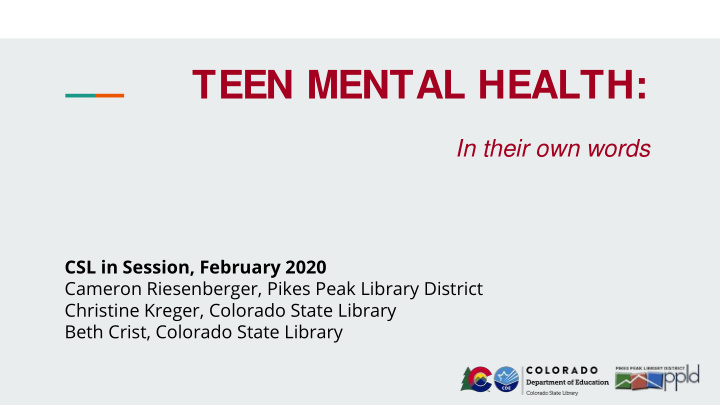



TEEN MENTAL HEALTH: In their own words CSL in Session, February 2020 Cameron Riesenberger, Pikes Peak Library District Christine Kreger, Colorado State Library Beth Crist, Colorado State Library
Number of suicides per year in Colorado, 2004-2018 Age: 10-19 years From the Colorado Department of Public Health & Environment
https://www.youtube.com/embed/zaAej0yw4gI?start=23&end=120
Commu muni nity *Risk Factors/Barriers Con onvers rsati tions t to o Inform orm Y You outh th *Protective Factors Suicide P Prevent ntion: n: *Recommendations A study i y in youth sui uicide i in fo four ur Col olora rado C Cou ounti ties https:/ / coag.gov/ app/ uploads/ 2019/ 05/ community-conversations-to-inform-yout h-suicide-prevention.pdf
Risk F Fac actor ors an and Bar Barriers Pressure/anxiety about failing Social media/cyberbullying ● ● Lack of prosocial activities (Sports, band, afterschool activities) Lack of connection to a caring adult ● ● Lack of acceptance or tolerance for people’s differences Poor employment/lack of economic opportunities in community ● ● Lack of coping skills/resilience in the face of challenges Generational poverty ● ● Substance abuse “Western Mentality” of solving your own problems rather than ● ● Adult and teen suicide is becoming normalized seeking help. ● Access to lethal means Mental health issues (depression, anxiety, etc.) ● ● Lack of resources/funding for public health and social services No time for teens to decompress/self-care ● ● programs Lack of mental health providers who accept Medicaid ● Lack of mental health providers trained to work with youth Lack of coordination/collaboration between health/service ● ● Stigma associated with help-seeking organizations ● Fear Compassion fatigue ● ● Lack of health insurance Need for trained gatekeepers – parents/family members/school ● ● personnel/youth peers “We are putting band aids on huge tears.” – School Staff
Prote otecti tive F Factors tors Community resources/youth suicide prevention efforts ● Increased collaborative efforts of the public health departments ● Access to extracurricular activities ● Access to faith-based organizations/activities ● Access to nature/outdoor activities/resources ● “ You are someone’s favorite person, so build relationships and connect with kids.” – School Staff
Reco Recommendations Prioritize relationship building between adults and youth. ● Create a culture of support for youth in crisis/post crisis. ● Implement programs or strategies that build resilience and coping skills. ● Increase access to prosocial activities and supportive environments. ● Leverage current public awareness campaigns to destigmatize getting help for mental health needs, ● including suicidal ideation. Create coalitions of providers and foster relationships between providers and youth serving organizations. ●
WHA HAT I T IS THE HE L LIBRARY’S ROL OLE?
https://research.ppld.org/toughtopics
https://www.namicoloradosprings. org/below-the-surface---colorado- crisis-text-line.html
Action P n Planni nning ng What is one thing you will share with your organization? What is one thing you will do in next month?
Thank nk Y You!
Recommend
More recommend